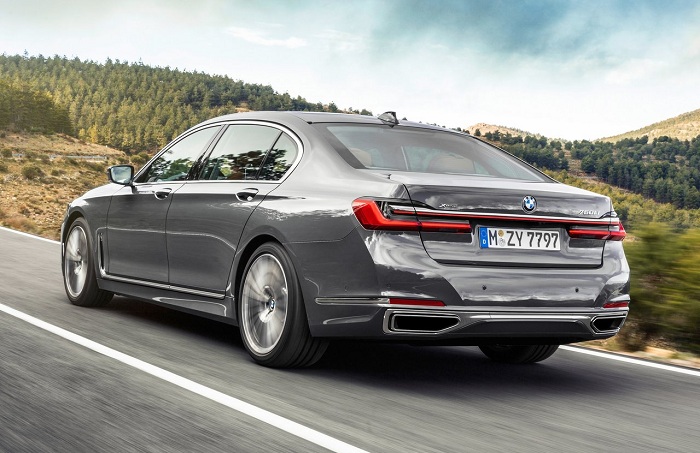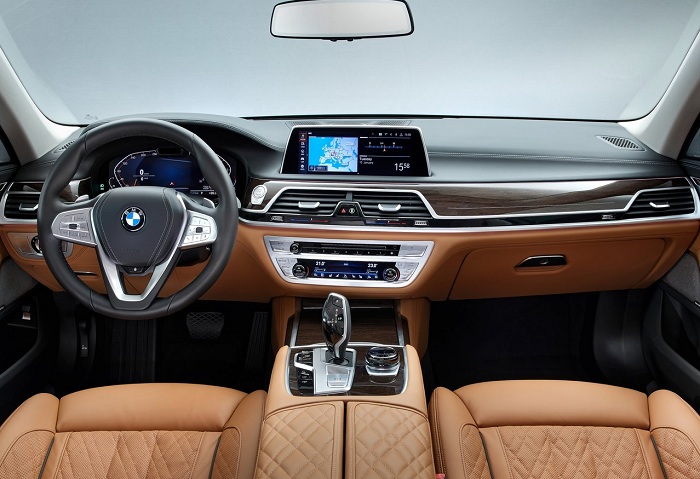The new looks
Billed as being an “interpretation of progressive luxury”, the latest Seven continues to carry the G11 internal moniker, but arguably rates the most opinion splitting model since the Chris Bangle-styled E65 debuted in 2001, mostly as a result of adopting a frontal appearance similar to the X7.
Measuring 5 120mm in overall length with a wheelbase of 3 210mm, width of 1 902mm and height of 1 467mm, the 7-series’ mentioned length has widened by 22mm and 14mm respectively, with the latter dimensions remaining unchanged. In addition to the standard model, the long wheelbase is also longer at 5 260mm.

As indicated by recent leak images, the 7-series’ controversial design includes mostly the front facia where the X7-esque kidney grilles are 40% wider than before in order, according to BMW, to aid air inflow and cooling. Raised by 50mm and offset by slimmer headlights equipped as standard with Adaptive LEDs or optional Laserlights, the final look is capped off by a new bonnet, reshaped bumper with enlarged side vents and new side panels with the so-called Air Breather ducts now upright in order to improve cooling.
Despite appearing similar to the outgoing model, the Seven’s rear-end receives new 3D light clusters that are not only 35mm thinner than before, but which are now connected by a single strip running the entire length of the bootlid. A new subtle lid spoiler, chrome finishes for the exhausts and newly designed alloy wheels with sizes ranging from 17-inch light-alloys to the optional 21-inch W-spoke items round the exterior off.
Subtle interior changes
Unlike its outside, the 7-series’ interior changes are minor and consists out of a selection of new material choices and colours, varying wood and aluminium inserts, the 10.25-inch iDrive infotainment system with 7.0 operating system, the 12.3-inch all digital instrument cluster and an optional Rear Entertainment system with dual 10-inch screens, wireless headphones and a Blu-Ray player.
Dynamically altered
Incorporating better insulation materials inside, BMW has also tweaked the 7-series underneath where all models receive a two-axle adaptive air suspension system with self-levelling dampers that raises the overall ride height by up to 20mm, new springs, the optional Integral Active rear-wheel steering system and a recalibrated electric power steering arrangement.
Safety first
While already equipped with an extensive array of driver assistance system, the Seven now comes outfitted with Active Cruise Control, Cross Traffic Alert, Night Vision camera, a colour Heads-Up Display, Reversing Assistant and Remote Control Parking via the BMW Display Key, surround view camera system, Lane Departure Warning, Autonomous Emergency Braking with Pedestrian Warning, City Braking and Cyclist Detection, Lane Change Warning, Traffic Jam Assist, Rear Collision Prevention, Driving Assistant and Rear Collision Prevention.
More power and xDrive for all
As previously reported, the 7-series’ range of engines are either tweaked units carried over from its predecessor or brand-new, with the latter applying to the 750i that gets the same 4.4-litre bi-turbo V8 petrol as the M850i with outputs of 390kW/750Nm. Despite initial claims of it being dropped, the M760Li returns as the flagship petrol with its 6.6-litre bi-turbo V12 churning out 430kW/850Nm.
In terms of performance, the 750i can be had in standard or long wheelbase bodystyles, with the former completing the benchmark 0-100km/h sprint 0.1 seconds faster than the latter at four seconds. Although BMW has retained the eight-speed Steptronic gearbox, the 750i, like the M850i, is now only offered solely with the brand’s xDrive all-wheel drive system.

At the sharp end, the long-wheelbase only M760Li will get to 100km/h from zero in 3.8 seconds, before topping at 250km/h or 305km/h when fitted with the optional M Driver’s Package. Unchanged is the combination of the eight-speed ‘box and xDrive all-wheel drive, though a Sport+ mode is now added to the M Drive mode selector.
One of only two models to offer the option of rear-or-all-wheel drive, the 730d serves as the entry-level diesel model with its single turbo 3.0-litre straight-six producing 195kW/620Nm, allowing it to go from 0-100km/h in 6.1 seconds or 6.2 seconds in 730Ld guise. Add in the xDrive system, times are reduced to 5.8 and 5.9 seconds respectively. Like its petrol siblings, indeed the rest of the range, the eight-speed auto is standard.
Still displacing 3.0-litres but with a second turbo added, the xDrive equipped 740d/740Ld makes 235kW/680Nm and will accelerate from 0-100km/h in 5.3 and 5.4 seconds, while the most powerful oil-burner, the 750d/750Ld not only comes with xDrive, but two additional turbochargers for a quad-blower setup, thus resulting in a output of 294kW/760Nm. The 0-100km/h sprint is dealt with in 4.6 and 4.7 seconds.
Completing the range, the 745e replaces the 740e as the plug-in hybrid option and comes in standard or long wheelbase guises, the latter having the option of the xDrive system. Gone though is the 2.0-litre turbocharged engine replaced with a 3.0-litre straight-six, that combines with an 83kW electric motor for a total system output of 290kW/600Nm. Able to sprint from 0-100km/h in 5.3 or 5.1 seconds, the 745e has an all-electric range of between 50 and 58km.
South African details
South African availability of the 7-series will commence in the second quarter and although final pricing is yet to be announced, the local line-up will be an all long wheelbase affair made up of the 750Li xDrive, M760Li xDrive, the 730Ld and the 745Le.

















